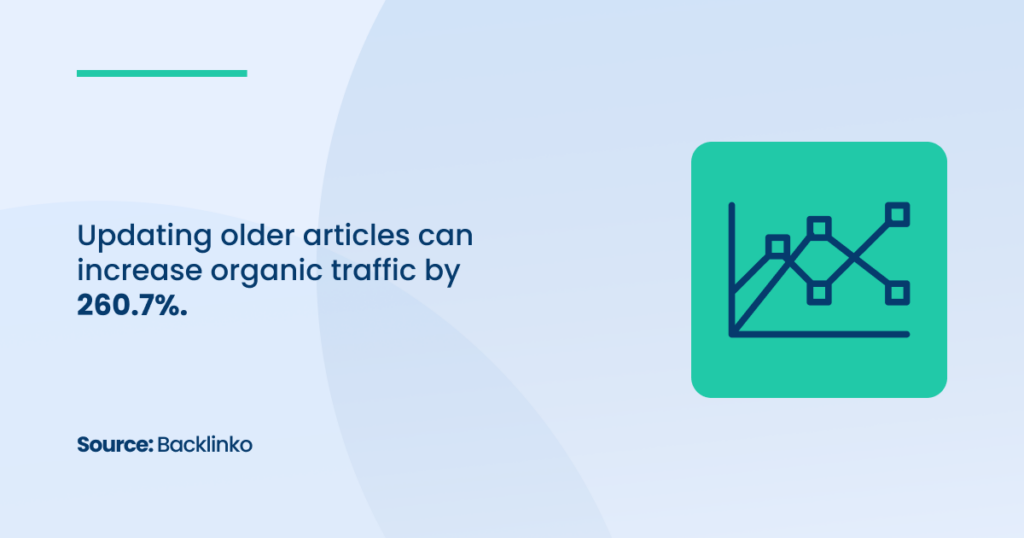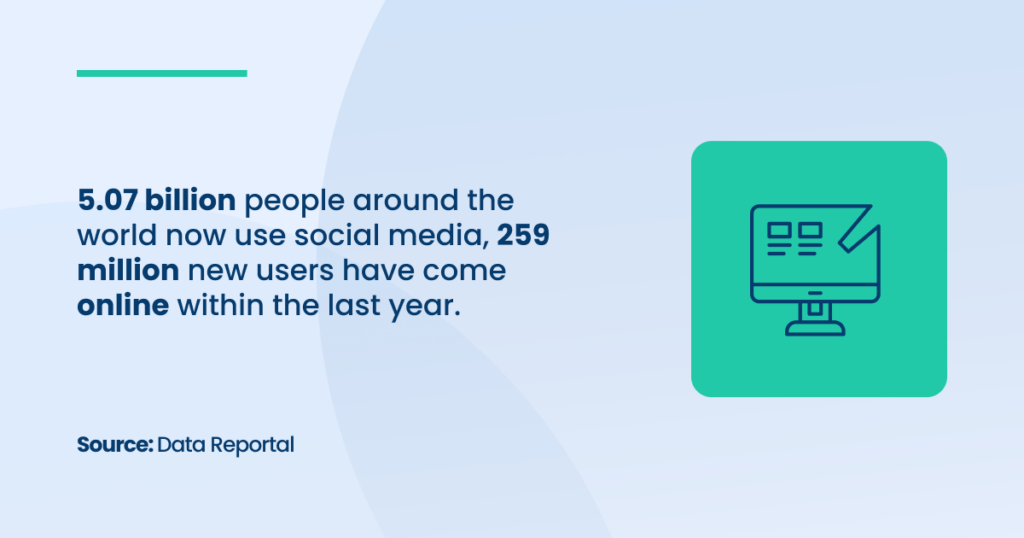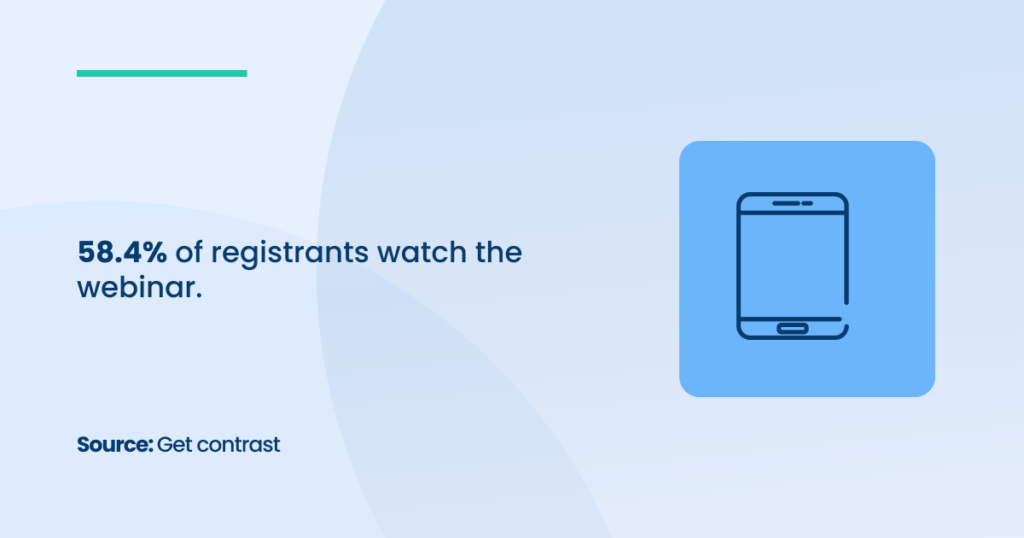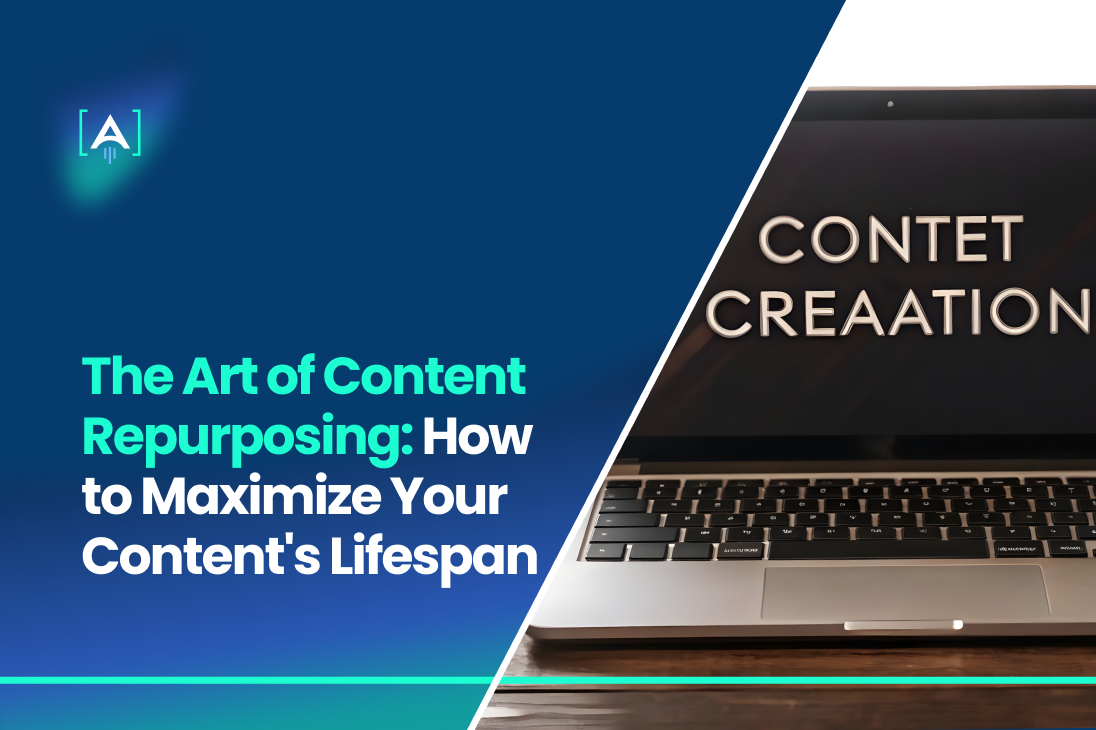Creating high-quality content is just the beginning in today’s fast-paced digital world.
To maximize its impact, extending its reach and lifespan is essential. This is where the art of content repurposing comes into play.
60% of marketers reuse their content two to five times.
Source: Hubspot
Hubspot notes that the reused content increased the monthly organic search views to posts we update and republish by an average of 106%.
Similarly, a quality Content Marketing Agency will develop a strategic repurposing plan that boosts visibility and engagement.
The blog post will explore effective repurposing techniques and best practices to help you improve the full potential of your content.
What is Content Repurposing?
Content repurposing refers to transforming existing content into new formats or distributing it on different platforms.
This approach allows marketers to maximize the value of their content, extending its lifespan and reach without constantly creating new material from scratch.

Whether converting a blog post into a video, transforming a webinar into a blog series, or repurposing content for social media, this strategy ensures that you get the most out of your content investments.
Benefits of Content Repurposing
Content repurposing comes with several advantages, including the ability to extend your content’s lifespan, reach new audiences, and improve your SEO performance.
- Reach New Audiences
One of the most significant benefits of content repurposing is its ability to help reach new audiences. Not all users consume content in the same format. Some prefer reading in-depth blog posts, while others enjoy watching videos or listening to podcasts.
By transforming your existing content into multiple formats, you can attract different types of audiences who might not have engaged with the original format.
- Save Time and Resources
Creating high-quality content requires significant time, effort, and resources. However, content repurposing allows you to maximize this investment by transforming one piece of content into multiple formats.
This saves you time and ensures you get the most return on investment (ROI) from each piece of content.
- Boost SEO and Website Traffic
Repurposing content also has significant SEO benefits. When you refresh or reformat existing content, you create new opportunities for that content to be discovered through organic search.
Optimizing your repurposed content for different platforms ensures that you target a broader range of keywords and reach a wider audience.
How to Identify High-Value Content for Repurposing
Content repurposing is an effective strategy to maximize the value of your existing content by transforming it into new formats and redistributing it across multiple channels. However, not all content is suitable for repurposing.
90% of marketers include content in their marketing strategies.
Source: SemRush
To truly maximize the impact of your content marketing efforts, it’s crucial to identify high-value content that can be effectively repurposed.
By focusing on evergreen topics, analyzing performance metrics, and paying attention to audience engagement, you can ensure that your content repurposing efforts will yield the best results.
Assessing Evergreen Content
Evergreen content is content that remains relevant and valuable over time, regardless of current trends or seasonal shifts. This type of content is ideal for repurposing because it continues to attract traffic and engagement long after its initial publication.
When identifying high-value content for repurposing, start by assessing which pieces fall into the evergreen category.
Characteristics of Evergreen Content
Evergreen content addresses timeless topics that your target audience consistently searches for and finds useful.
For example, an article titled “How to Create a Winning Content Strategy” will likely remain valuable for years, while an article focused on a current event or a trend may lose its relevance quickly. Evergreen content is not tied to a specific time or event, making it ideal for repurposing into different formats.
For instance, if you have a blog post that explains the fundamentals of digital marketing, you can turn it into various other content formats, such as video content, social media posts, or even an interactive infographic.
Similarly, branded content marketing efforts can benefit from transforming this evergreen content into augmented reality content or content gamification to create an engaging experience for your audience.
When assessing your existing library of content, identify pieces that cover timeless topics related to your industry. Content that answers common questions, provides how-to guides, or shares best practices is perfect for repurposing.
Ways to Repurpose Evergreen Content
Once you’ve identified evergreen content, consider how it can be repurposed. Repurposing content for social media is an excellent way to reach a wider audience.
For example, you can break down long-form blog posts into bite-sized pieces for social media platforms, create quotes and tips to share in social media posts, or turn key insights into a series of video content for YouTube or Instagram.
Moreover, evergreen content can be turned into interactive content marketing assets. For example, a detailed guide could be repurposed as an online quiz or assessment tool, allowing users to interact with the content in a more personalized way.
This not only adds value but also enhances user engagement and helps attract new leads.
Analyzing Past Performance
Another important step in identifying high-value content for repurposing is to analyze the past performance of your existing content.
By leveraging analytics tools, you can easily determine which content pieces have resonated with your audience and driven the most engagement. High-performing content is an indicator that your audience finds it valuable, making it a great candidate for repurposing.
Key Performance Metrics to Track
When evaluating content performance, several key metrics can help you identify which pieces are worth repurposing:
- Page Views and Traffic: High traffic indicates that the content is already drawing attention, making it more likely to succeed when repurposed into other formats.
- Time on Page: Content with a high average time on the page suggests that users find it engaging and valuable, indicating the potential for further repurposing.
- Bounce Rate: Content with a low bounce rate shows that visitors are sticking around to explore more. This type of content is great for repurposing because it clearly holds the attention of your target audience.
- Social Shares and Engagement: Content that is frequently shared on social media is a strong candidate for repurposing into repurposed content for social media or as part of a broader branded content marketing campaign.
- Conversions: High-converting content indicates that it resonates with your audience and prompts them to take action, making it worth extending into new formats or channels.
By analyzing these metrics, you can pinpoint content that has already proven to be successful.
For example, if a particular blog post has generated a lot of traffic and social shares, you might repurpose it as a video tutorial or infographic, extending its reach and visibility.
How to Leverage High-Performing Content
Once you’ve identified your top-performing content, you can start thinking about how to repurpose it effectively.
Video content is particularly useful in today’s digital landscape, as it engages users across multiple platforms.
You can turn a high-performing blog post into a video series or repurpose the information into a webinar that adds even more value to your audience.
90% of marketers say video marketing has given them a good ROI.
Source: Wyzovl
Similarly, repurposing successful blog content into interactive content marketing formats can enhance user engagement.
For instance, if a particular article has performed well, you can transform it into a podcast or create a slide presentation to share on LinkedIn or SlideShare. This multi-format approach ensures that your content reaches a wider range of users with varying preferences.
Identifying Audience Engagement
Audience engagement is a crucial factor when identifying high-value content for repurposing.
Content that sparks conversation encourages comments or generates likes and shares is a clear indicator that it resonates with your target audience.
By focusing on content your audience actively engages with, you increase the likelihood that your repurposed content will succeed similarly.
Social Media Engagement
Repurposing content for social media allows you to tap into conversations and interactions that your audience is already having. 93.3% of internet users are using social media, and the gender split is fairly balanced.

Suppose a blog post has received numerous comments or shares on social media. In that case, it’s a good candidate for repurposing into bite-sized social media posts or even turning into a more visual medium like an infographic. Creating content that encourages more interaction can build stronger relationships with your audience and drive further engagement.
For example, turning a well-received blog post into a Twitter thread or Instagram carousel can breathe new life into the content and make it more shareable.
Likewise, interactive content marketing techniques such as polls, quizzes, or live Q&A sessions based on your existing content can help engage your audience in real time, making them feel more connected to your brand.
User-Generated Content and Feedback
Another way to gauge audience engagement is through user-generated content and feedback.
Content that encourages users to share their own experiences, opinions, or creations is highly valuable because it fosters a sense of community.
Consider incorporating this into your repurposing strategy if you’ve received significant feedback or user-generated content on a particular topic.
For example, you can create a case study or success story based on your audience’s experiences or use their testimonials in your next branded content marketing campaign.
User feedback can also be an invaluable resource for refining your content repurposing efforts.
By paying attention to your audience’s comments and questions, you can identify new content ideas and formats that will resonate with them.
For example, if you receive a lot of questions about a particular blog post, you might consider turning the post into an FAQ page or a how-to video to address those inquiries directly.
Engaging with Multiple Platforms
The key to effective repurposing is ensuring that your content reaches audiences across different platforms. While some users prefer reading long-form articles, others may engage more with visual or interactive formats.
Source: The Use of Social Media Platforms, Statista
By leveraging content curation and repurposing your high-value content into various formats for different platforms, you increase the chances of reaching a broader audience.
For example, you can repurpose an in-depth article into an augmented reality content experience for Instagram or create a content gamification feature that makes the material more interactive and engaging for users.
Diversifying your content formats helps cater to different audience preferences while ensuring your message remains consistent and compelling.
Repurposing Strategies for Different Content Formats
Content repurposing is an essential strategy for maximizing the value of the content you create.
By adapting existing content into new formats, you can extend its reach, improve engagement, and provide value across multiple channels.
Whether you’re repurposing blog posts, webinars, or podcasts, transforming your content for different formats allows you to engage diverse audiences and maximize your content’s lifespan.
Blog Posts
Blog posts are one of the most versatile types of content when it comes to repurposing.
Well-written content that is informative, educational, or entertaining can be transformed into a wide range of formats, providing new ways for audiences to engage with it.
Turning Blog Posts into Social Media Posts
Repurposing content for social media is a highly effective way to reach a broader audience.
92% of bloggers are driving traffic to their content via social media.
Source: Orbit media
Social media channels such as Facebook, Twitter, LinkedIn, and Instagram each have unique formats and audiences, so it’s essential to adapt your blog posts to suit these platforms. By breaking down long-form blog posts into bite-sized content, you can increase engagement while ensuring your message remains consistent.
To repurpose a blog post into social media content, start by extracting the key takeaways, statistics, and quotes.
These can be used as individual social media posts, providing value to your audience without overwhelming them with too much information at once.
Based on the blog post’s insights, you can also create interactive content marketing elements such as polls, quizzes, or infographics.
Infographics, in particular, are highly shareable and can visually represent the key points from the blog, making them appealing across various platforms.
Using tools content marketing platforms like Buffer, Hootsuite, or CoSchedule can help you schedule and automate your repurposed social media posts. This ensures consistency and saves time while allowing you to reach your audience on different social media platforms.
Webinars
Webinars are excellent sources of valuable content because they often contain in-depth insights, expert opinions, and interactive elements that can be transformed into different formats.

Webinars, however, are long-form content that may not always suit the preferences of every audience, so repurposing them into more digestible formats can significantly increase their reach.
Turning Webinars into Blog Posts
One of the most efficient ways to repurpose webinars is by converting them into blog posts. Since webinars usually cover extensive topics, they can provide a wealth of information to draw from when creating blog posts.
You can break down a single webinar into multiple blog posts, each focusing on different aspects of the discussion.
For example, if your webinar covered “AI in Marketing,” you could create blog posts on individual topics discussed during the session, such as “The Role of AI in Personalization” or “How AI Can Improve Your SEO Strategy.”
This strategy allows you to target specific keywords for search engines while providing valuable content to your audience.
Podcasts
Podcasts are another powerful medium for content creation, allowing brands to connect with their audience in an intimate and conversational format.
However, not everyone prefers audio content, so repurposing podcasts into other formats is essential to reach a broader audience.
Podcast to Blog Post Transcriptions
A great way to repurpose podcast episodes is by transcribing them into blog posts. Podcast transcriptions not only make your content more accessible to those who prefer reading but also help improve your website’s SEO.
Search engines can index the written content, making it easier for users to find your podcast through organic searches.
Source: Percentage of consumers who are aware of podcasting in the United States, Statista
To turn a podcast episode into a blog post, start by transcribing the audio and editing it into a well-structured post.
You can either present the content as a direct transcription or reformat it into a more traditional blog format by summarizing the key points discussed during the episode.
For example, if your podcast covered “The Future of Digital Marketing,” you can structure the blog post to highlight the main takeaways, such as emerging trends, expert advice, or actionable strategies for marketers.
You can also include additional insights and links to other relevant content or sources to provide more value to your readers.
Additionally, podcasts can be repurposed into social media channels by taking snippets of key sound bites and turning them into audio clips or quotes for sharing.
These repurposed content for social media posts can help promote the podcast episode while engaging your audience on different platforms. Pairing the audio clips with visually appealing graphics or videos can further enhance engagement.
You can also create interactive content marketing elements from podcasts, such as polls or quizzes, based on the topics discussed in the episode.
For example, after transcribing a podcast episode about SEO best practices, you could create an interactive quiz that tests users’ knowledge of SEO strategies.
Additional Content Repurposing Ideas
While blogs, webinars, and podcasts are some of the most common content formats to repurpose, there are many other ways you can get creative with content repurposing:
- Ebooks and Whitepapers: If you’ve created a series of blog posts or a long-form guide, consider repurposing that content into an ebook or whitepaper. This provides additional value to your audience while positioning your brand as a thought leader.
- Case Studies: You can repurpose content from webinars, interviews, or success stories into detailed case studies that showcase your expertise and the value your brand brings to clients or customers.
- Infographics: If you have a blog post or webinar with a lot of data or statistics, consider turning that information into an infographic. Infographics are highly shareable and can be used across various platforms, from social media to email newsletters.
Partner with [A] Growth Agency for Your Content Strategy to Maximize the Lifespan
Repurposing content doesn’t just save time. It ensures that high-quality content reaches new audiences who might have missed it the first time around.
[A] Growth Agency will define your strategies for getting the desired results.
We specialize in turning entrepreneurial dreams into reality with effective, tailored growth strategies.
Growth is our driving force, but speed and execution are our keys to success.
By combining innovative digital marketing techniques and data-driven insights, we craft strategies to accelerate growth.
That is not the whole we offer.

